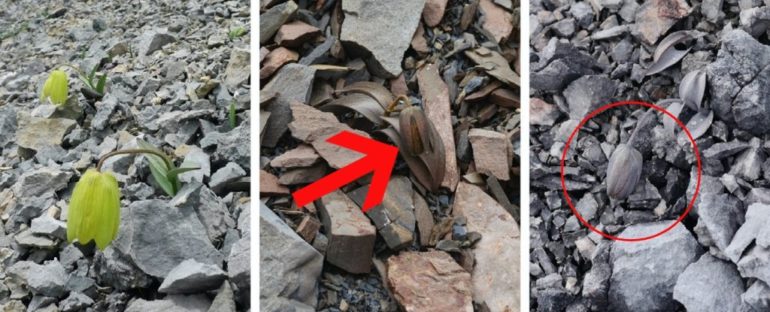On the wide open slopes of China’s Hengduan Mountains, there are perks to being a wallflower. After thousands of years of human harvesting, a rare alpine flower – prized in Chinese medicine – is trying its hardest not to stand out.
In the alpine meadows where humans pluck the Fritillaria delavayi plant the most, scientists have noticed the perennial herb blends in better with the rocky background.
Avoiding the limelight in a drab environment is no easy feat when your leaves and bulbs are normally a bright green, so some populations of F. delavayi have turned more of a brown or grey to better match their surroundings.
Many plants are capable of such camouflage, usually as an attempt to hide from hungry hunters, but up here, the only real predators are us.
“Like other camouflaged plants we have studied, we thought the evolution of camouflage of this fritillary had been driven by herbivores, but we didn’t find such animals,” explains botanist Yang Niu from the Kunming Institute of Botany.
“Then we realised humans could be the reason.”
Normal green plants with low harvest pressure (A and B) and camouflaged individuals with high harvest pressure (C and D). (Niu et al., Current Biology, 2020)
Speaking to locals in the area, researchers estimated how each accessible population of alpine herb had been harvested over the past five years.
Using a model for human vision, researchers found significant colour diversity among herb populations – especially those that existed in areas with high levels of human harvesting.
This suggests human behavior is somehow shaping the evolution of these famous herbs, which are the most commonly used treatment in China for coughs and phlegm.
F. delavayi plants sport a set of leaves that vary in colour from grey to brown, but it’s only after their fifth year of life that they begin to produce annual bulbs of similar shades. Over 3,500 individual bulbs are needed to make just a kilogram of medicine.
This slow and minimal growth is part of what makes the rare herb so cherished, but it’s also what makes it vulnerable to overharvesting.
Changing colour is probably one of the only defences this plant has got against increased harvesting from humans. And so, it seems, the more we want it, the harder it is to find.
To further test the plant’s camouflage on real human vision, researchers set up a computer experiment in which participants were asked to locate various colours of the herb in 14 slides of its natural environment.
As expected, the more-camouflaged and less green plants were harder to locate as quickly.
“It’s remarkable to see how humans can have such a direct and dramatic impact on the colouration of wild organisms, not just on their survival but on their evolution itself,” says botanist and ecologist Martin Stevens from the University of Exeter.
“It’s possible that humans have driven evolution of defensive strategies in other plant species, but surprisingly little research has examined this.”
The rare snow lotus is one of the few examples we have. Historically collected by humans, studies have shown this coveted plant has grown significantly smaller in the past hundred years.
There’s even a theory that humans unconsciously drove the evolution of weeds from a pest to something more similar to wheat as plants tried to avoid being torn out of the ground.
That’s a fascinating idea, and further research on harvested wild plants like F. delavayi might help us better understand what aspects of plant biology humans are truly capable of influencing.
The study was published in Current Biology.
